Steel Markets

SMU Construction Analysis: CPIP Data Positive in October
Written by Peter Wright
December 6, 2018
Construction in the United States is experiencing strong growth led by nonresidential building and infrastructure expenditures, according to Steel Market Update’s analysis of the latest Commerce Department Construction Put in Place data.
On Dec. 3, Commerce released CPIP expenditures data for October. The growth of total construction on a rolling 12-month basis year over year increased every month in a range from 2.0 percent in March to 4.5 percent in October. On a rolling three-months, the situation is even better with growth improving every month from November last year at 0.9 percent through October 2018 when it reached 6.4 percent.
SMU analyzes the CPIP data with the intent to provide a clear description of activity that accounts for about 45 percent of total U.S. steel consumption. See the end of this report for more detail on how we perform this analysis and structure the data. In particular, note that we present non-seasonally adjusted numbers and we don’t include expenditures for residential improvements. Our rationale is that construction is highly seasonal and our businesses function in a seasonal world, and home improvements don’t consume much steel. The growth or contraction that we report in this analysis has had seasonality removed by providing only year-over-year comparisons. For these reasons, our results may not align with other sources.
Total Construction
Total construction expanded by 6.4 percent in three months through October and by 4.5 percent in 12 months through October, both year over year. Since the three-month growth rate is higher than the 12-month rate, we conclude that momentum is positive. October construction expenditures totaled $100.3 billion, which breaks down to $71.2 billion of private work, $27.3 billion of state and locally funded (S&L) work, and $1.8 billion of federally funded work (Table 1). Growth trend columns in all four tables in this report show momentum.
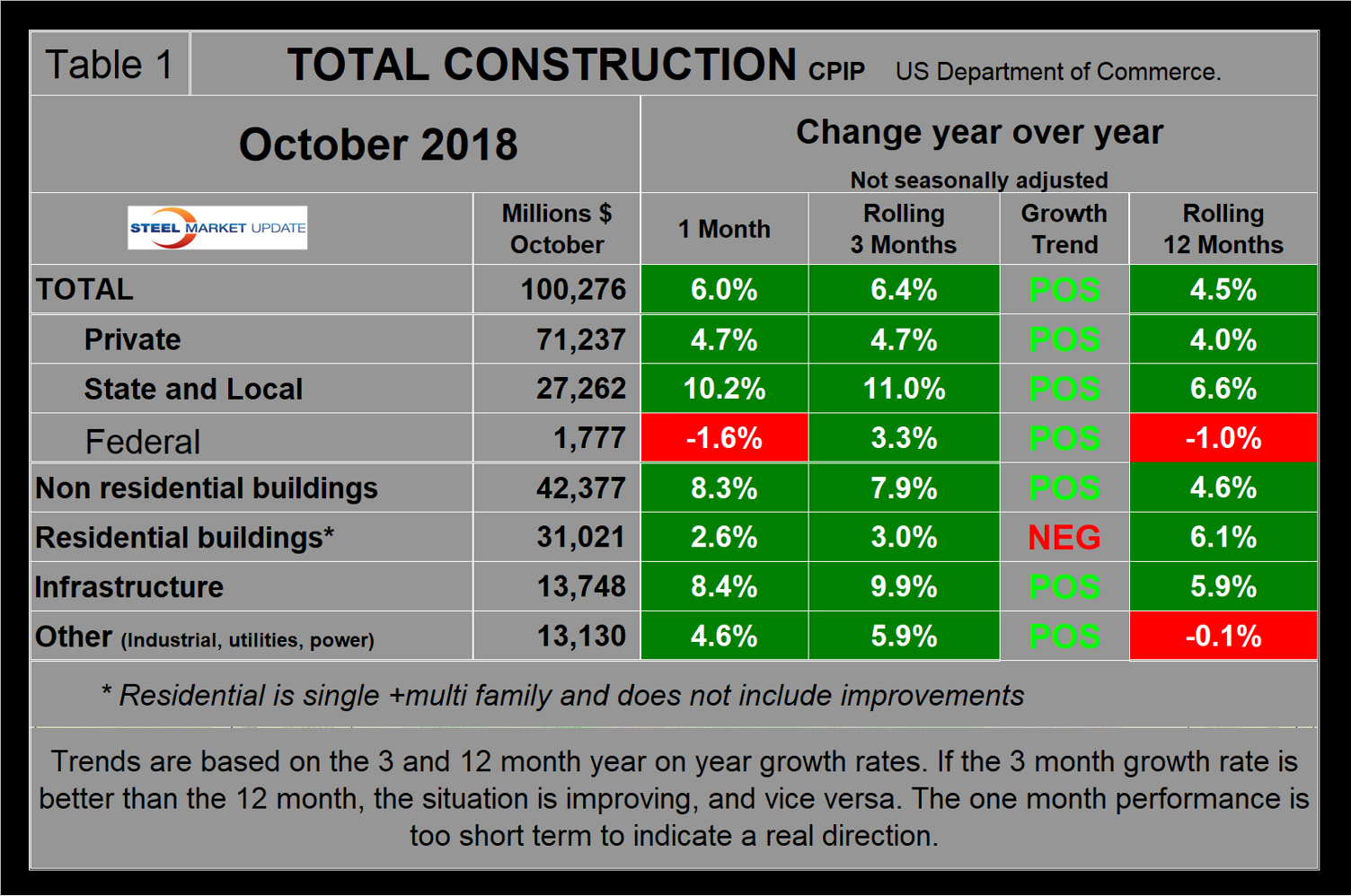
Figure 1 shows total construction expenditures on a rolling 12-month basis as the blue line and the rolling three-month year-over-year growth rate as the brown bars. Total construction is at an all-time high and growth has accelerated throughout 2018.
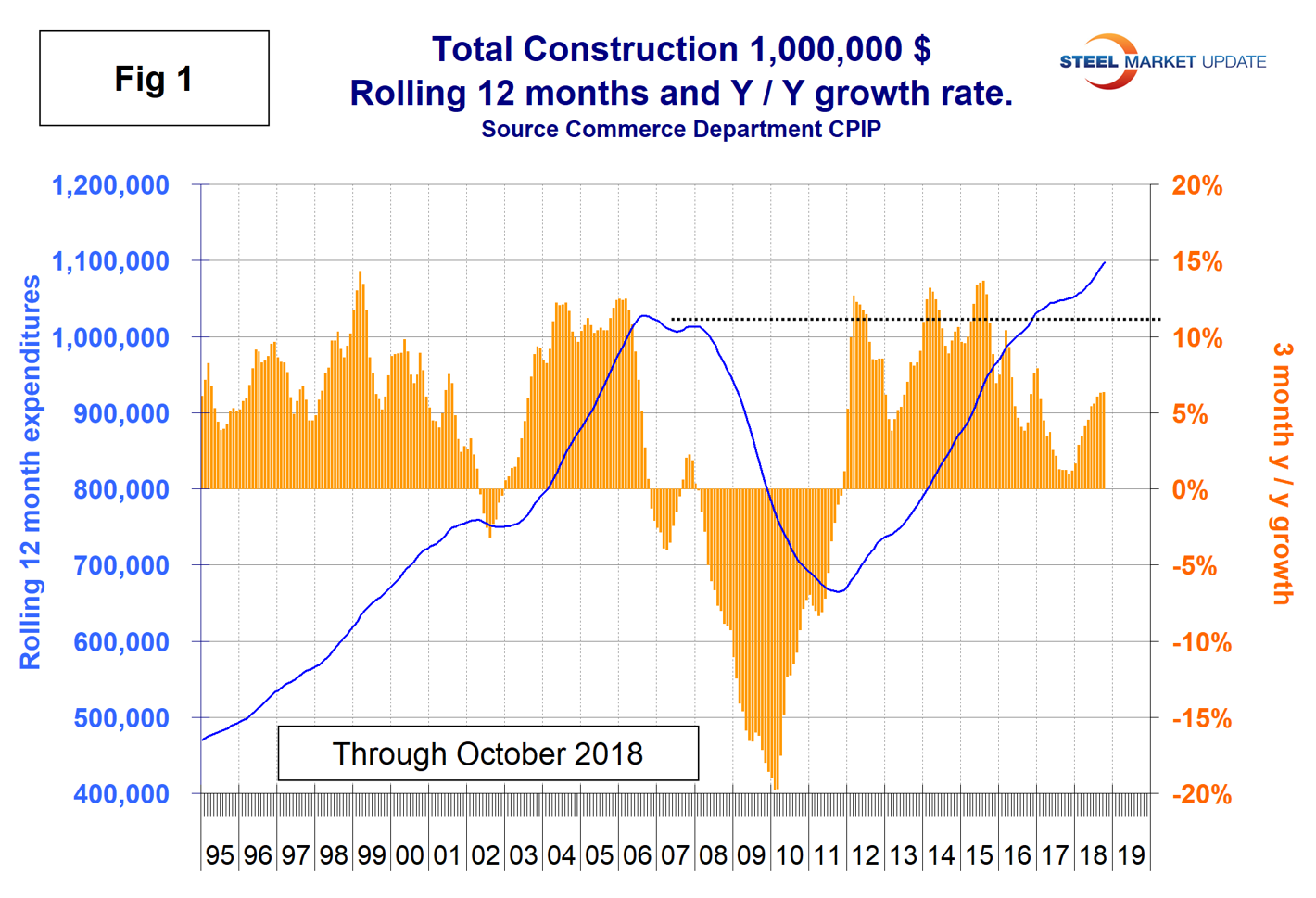
Figures 1, 2, 6, 7 and 9 in this analysis have the same format, the result of which is to smooth out variation and eliminate seasonality. We consider four sectors within total construction: nonresidential, residential, infrastructure and other. The latter is a catchall and includes industrial, utilities and power. Of these four sectors, only residential buildings had negative momentum in the October data, which was the same as the previous nine months’ results.
The pre-recession peak of total construction on a rolling 12-month basis was $1.028 trillion through November 2006. The low point was $665.1 billion in the 12 months through April 2011. In 12 months through October 2018, construction expenditures totaled $1.097 trillion. (This number excludes residential improvements; see explanation below.)
Private Construction
Table 2 shows the breakdown of private expenditures into residential and nonresidential and subsectors of both. The growth rate of private construction in three months through October 2018 was 4.7 percent, up from 1.9 percent in the three months through last November as shown by the brown bars in Figure 2. May was the first month for the rolling 12-month total of private construction expenditures to exceed the pre-recession peak that occurred in September 2006. Private construction expenditures have increased every single month since September 2011 on a rolling 12-months basis.
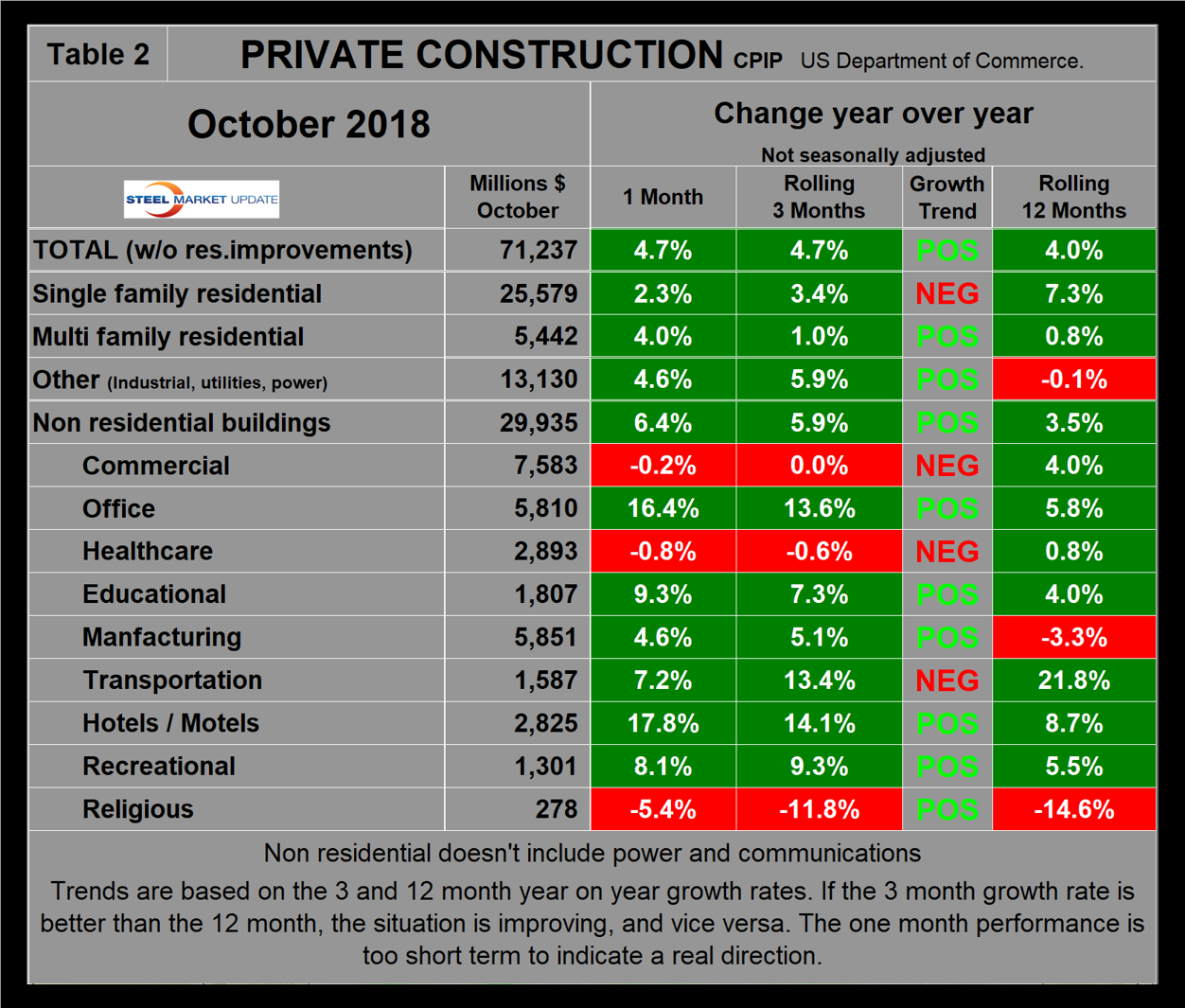
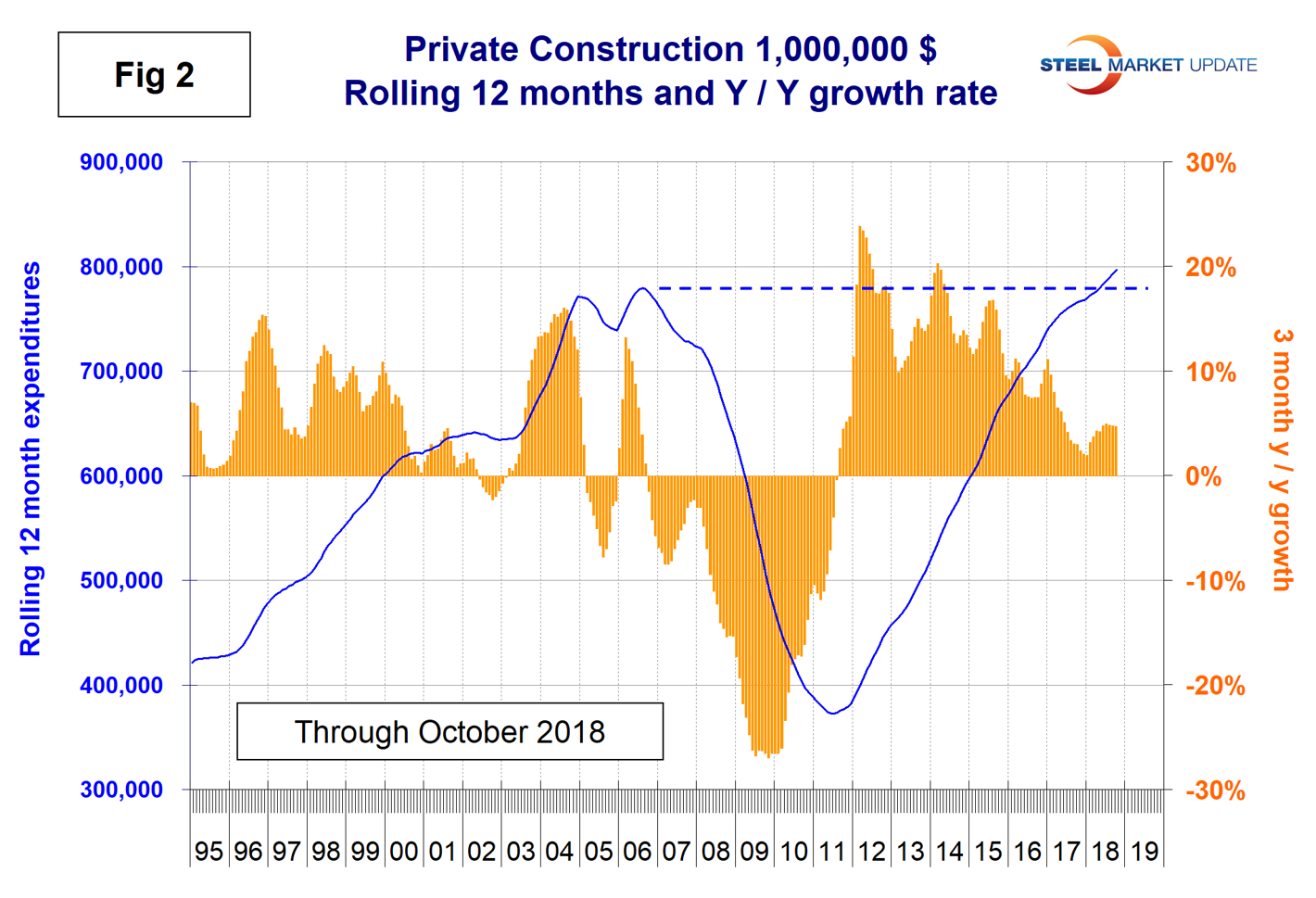
Within private non-residential building, momentum was mixed with six positive sectors and three negative (commercial, healthcare and transportation). The weakest category is religious buildings, which have had negative growth year over year every month since March 2017.
Excluding property improvements, our report shows that single-family residential grew by 3.4 percent in three months through October with negative momentum and multifamily residential grew by 1.0 percent with positive momentum. The higher federal funds rate is starting to show its effects in the housing sector. Housing starts, existing and new home sales, as well as other housing-related data, have been mostly disappointing in recent months. This is predominantly due to the rise in mortgage rates, a direct effect of a higher federal funds rate. In September, the MBA 30-year mortgage rate exceeded 5.0 percent for the first time since 2011. The single-family market is also experiencing headwinds from the effects of tax reform. Homebuilder sentiment has been declining since February and the decline accelerated in November.
The Census Bureau reports on construction starts in its housing analysis. In the starts data, the whole project is entered into the database when ground is broken. Construction put in place is based on spending work as it proceeds; the value of a project is spread out from the project’s start to its completion. Single-family starts grew by 1.5 percent in the three months through October year over year, which was lower than the growth rate of CPIP. Multifamily starts grew by 8.4 percent, which was quite a bit higher than CPIP. Figure 3 shows the growth of both housing sectors since January 2005 and Figure 4 shows the ratio of single-family to multifamily starts. The proportion of single-family has been gradually increasing since October 2015 when the ratio was 1.66 in favor of single units to 2.54 in October 2018. Figure 5 shows total housing starts in four regions with the South being the strongest and the Northeast the weakest.
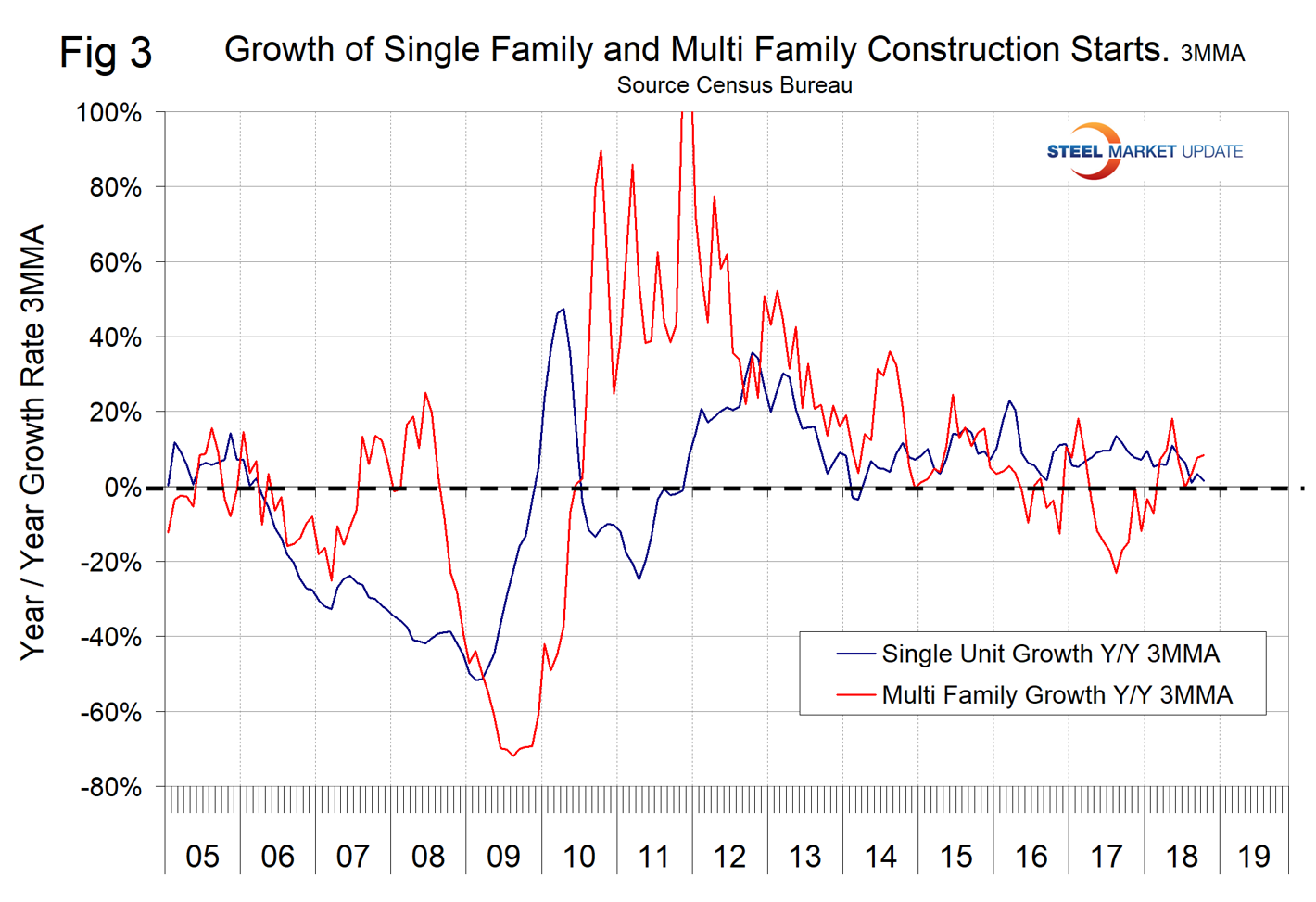
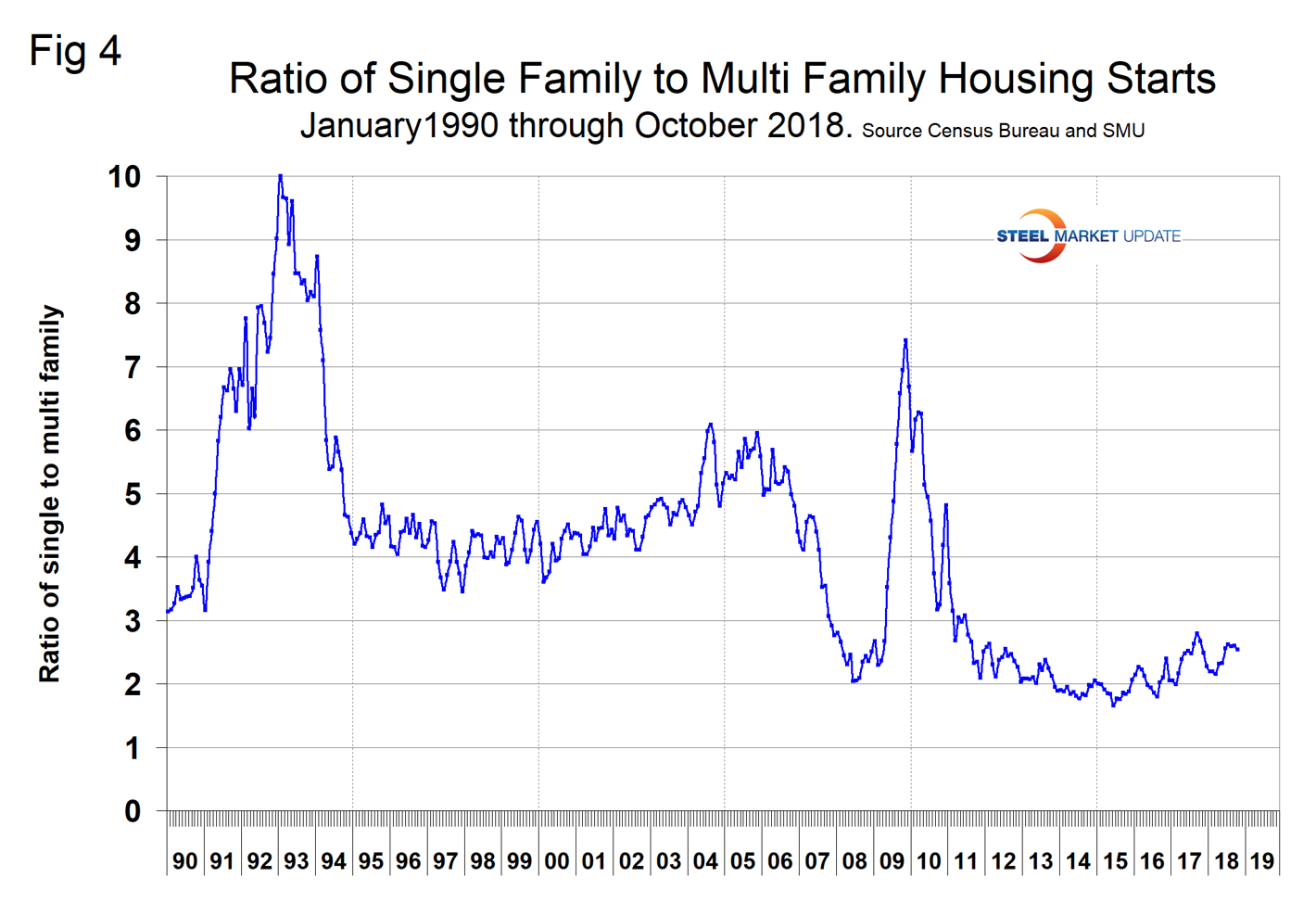
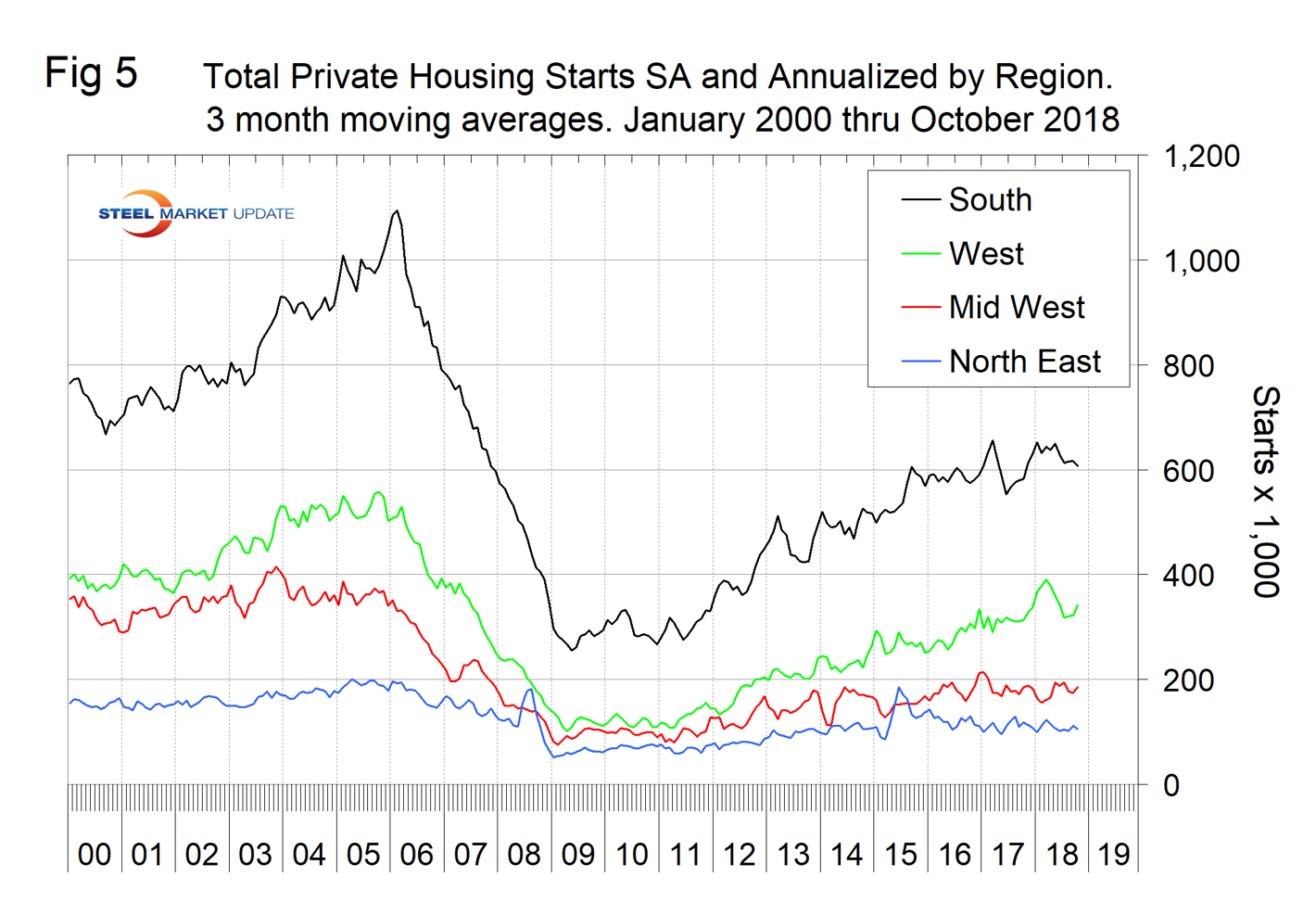
State and Local Construction
S&L work has expanded and accelerated every month this year. In October, the year-over-year growth rate on a rolling three months basis reached 11.0 percent, up from 0.9 percent in January and negative growth every month in 2017 (Table 3). S&L nonresidential buildings and infrastructure, both of which are included in the S&L data, had positive momentum. Table 3 shows that S&L nonresidential buildings expanded by 12.7 percent in three months through October. Educational is by far the largest subsector of S&L nonresidential buildings at $6.2 billion in October and experienced an 8.0 percent positive growth on a rolling three months basis with positive momentum. Figure 6 shows the history of total S&L expenditures. In previous updates, we have stated that a full recovery of S&L construction wouldn’t happen in this decade. The growth of this sector has exceeded our expectations in the last three months and is now so great that this conclusion may be in doubt.
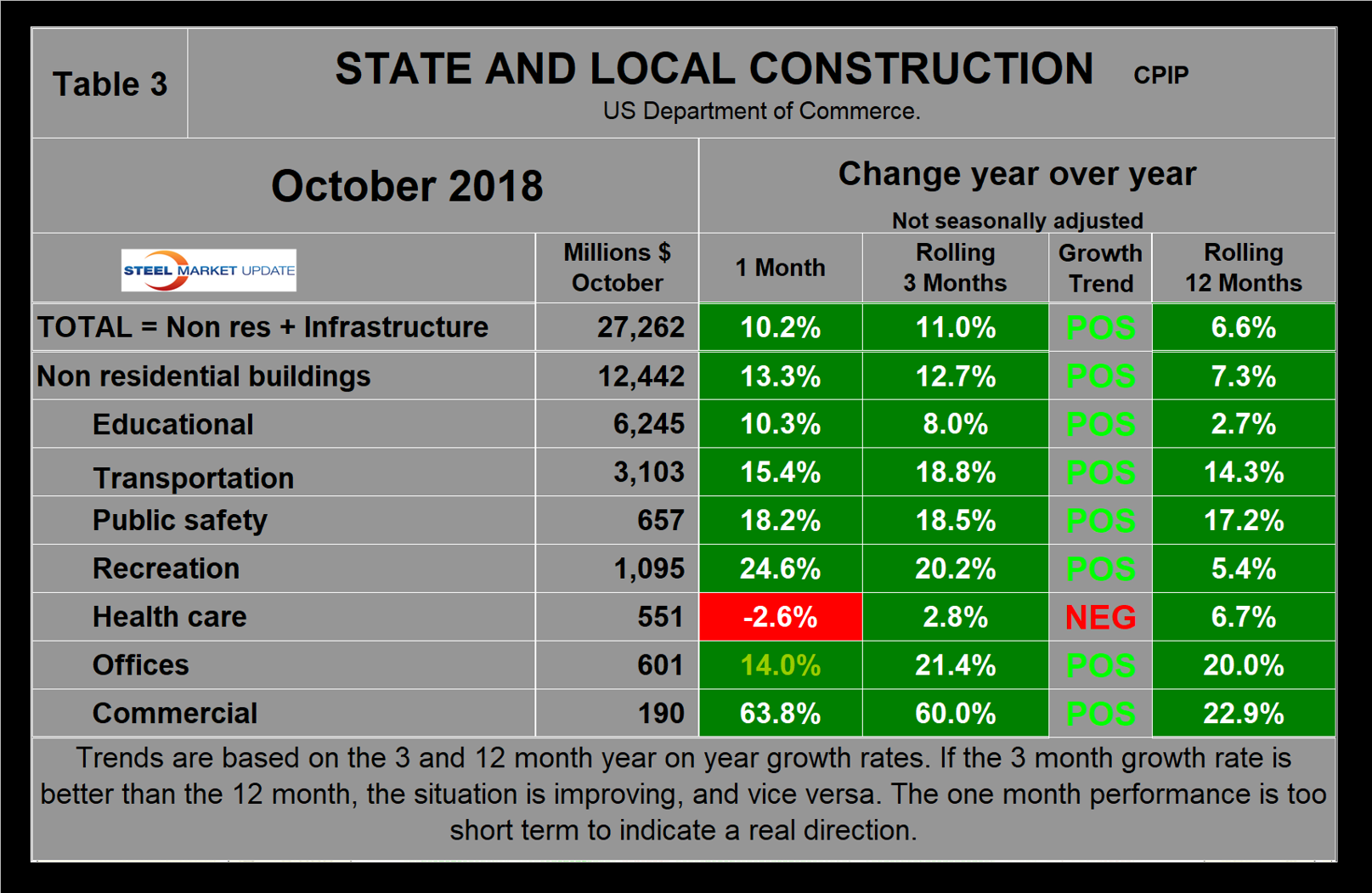
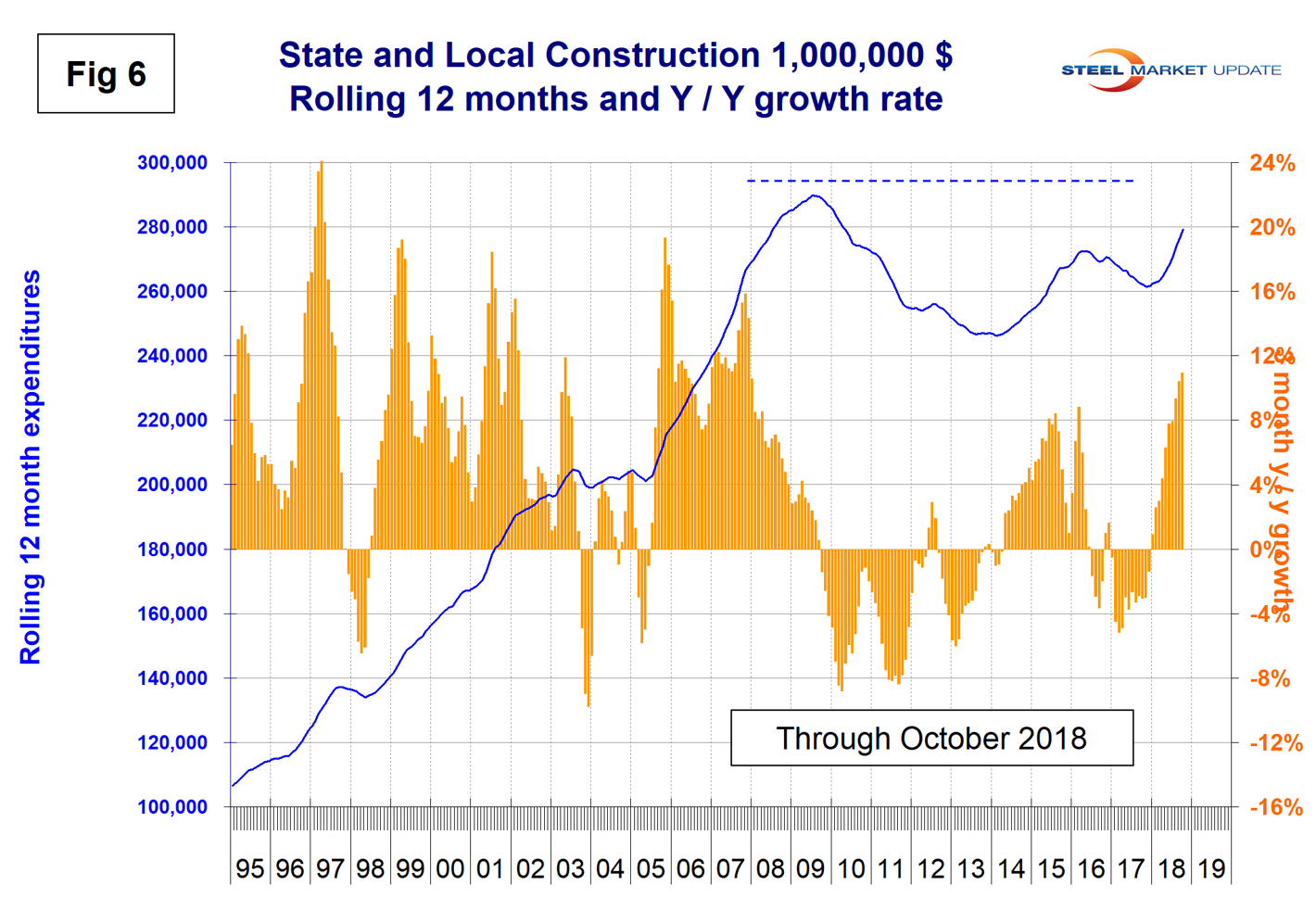
Drilling down into the private and S&L sectors as presented in Tables 2 and 3 shows which project types should be targeted for steel sales and which should be avoided. There are also regional differences to be considered, data for which is not available from the Commerce Department.
Infrastructure
Infrastructure expenditures peaked in early 2016 and declined through 2017 before beginning a robust recovery in 2018. October had a 9.9 percent growth rate. Highways and streets including pavement and bridges account for about two-thirds of total infrastructure expenditures. Highway pavement is the main subcomponent of highways and streets and had a 12.7 percent growth in three months through October. Bridge expenditures achieved positive growth last December for the first time in almost two years and steadily improved until the September and October data, which were barely positive (Table 4).
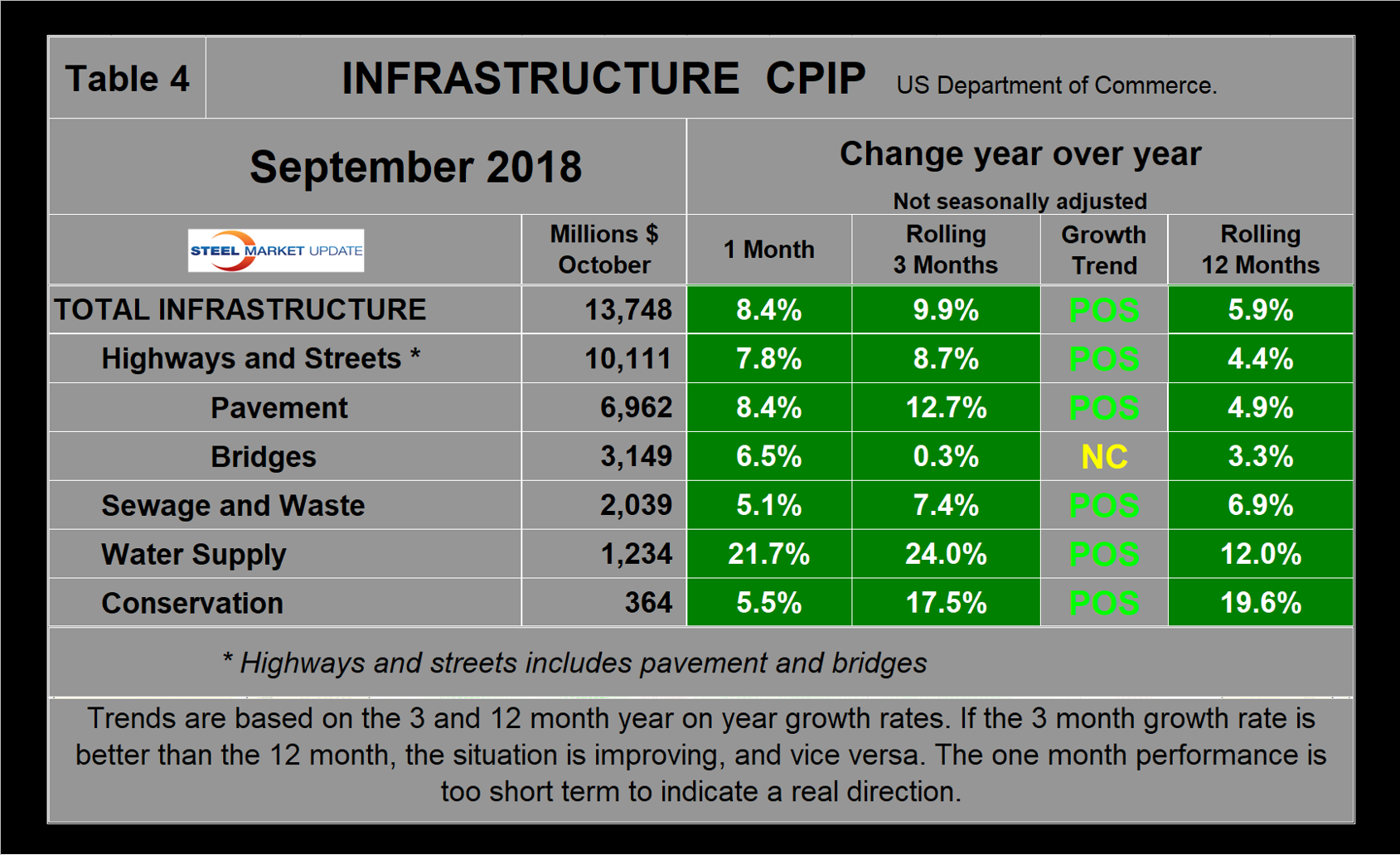
Figure 7 shows the history of infrastructure expenditures and the year-over-year growth rate.
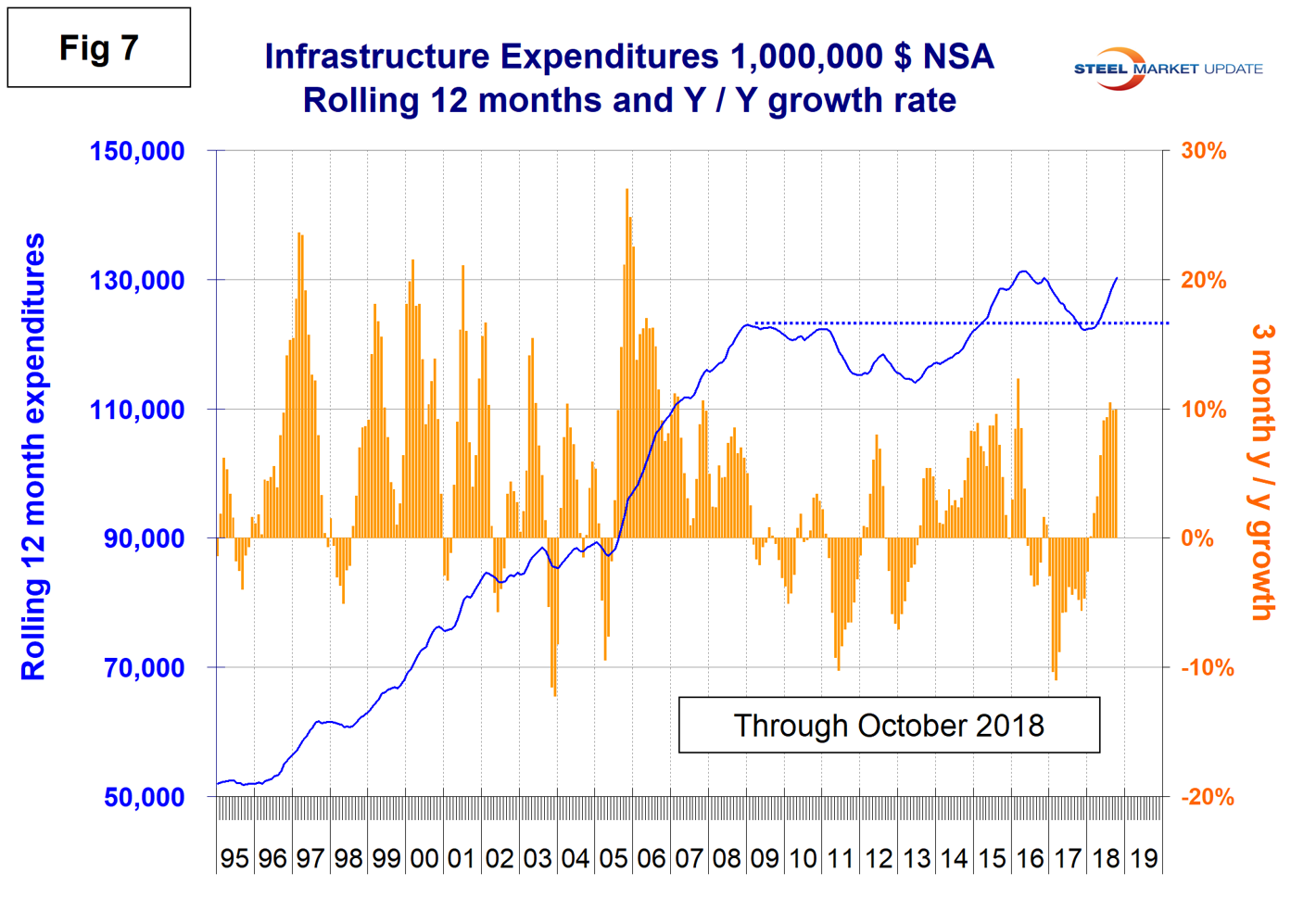
Total Building Construction Including Residential
Figure 8 compares year-to-date expenditures for building construction for 2017 and 2018. Single-family residential is dominant and in the 12 months of 2017 totaled $264.5 billion, up from $242.5 billion in 2016. The rate through the first nine months of 2018 was $287.4 billion. It seems likely that the 2018 tax bill, by its reduction in the deductibility of mortgage interest and local taxes, will negatively affect single-family home construction. The Architecture Billings Index (ABI) topped the breakeven 50 mark for the 13th month in a row in October, with a seasonally adjusted score of 50.4, down from 51.1 in September. The ABI measures the percentage of surveyed architecture firms that reported higher billings than a month earlier, less the percentage reporting lower billings; any score above 50, on a 0-100 scale, indicates an increase in billings.
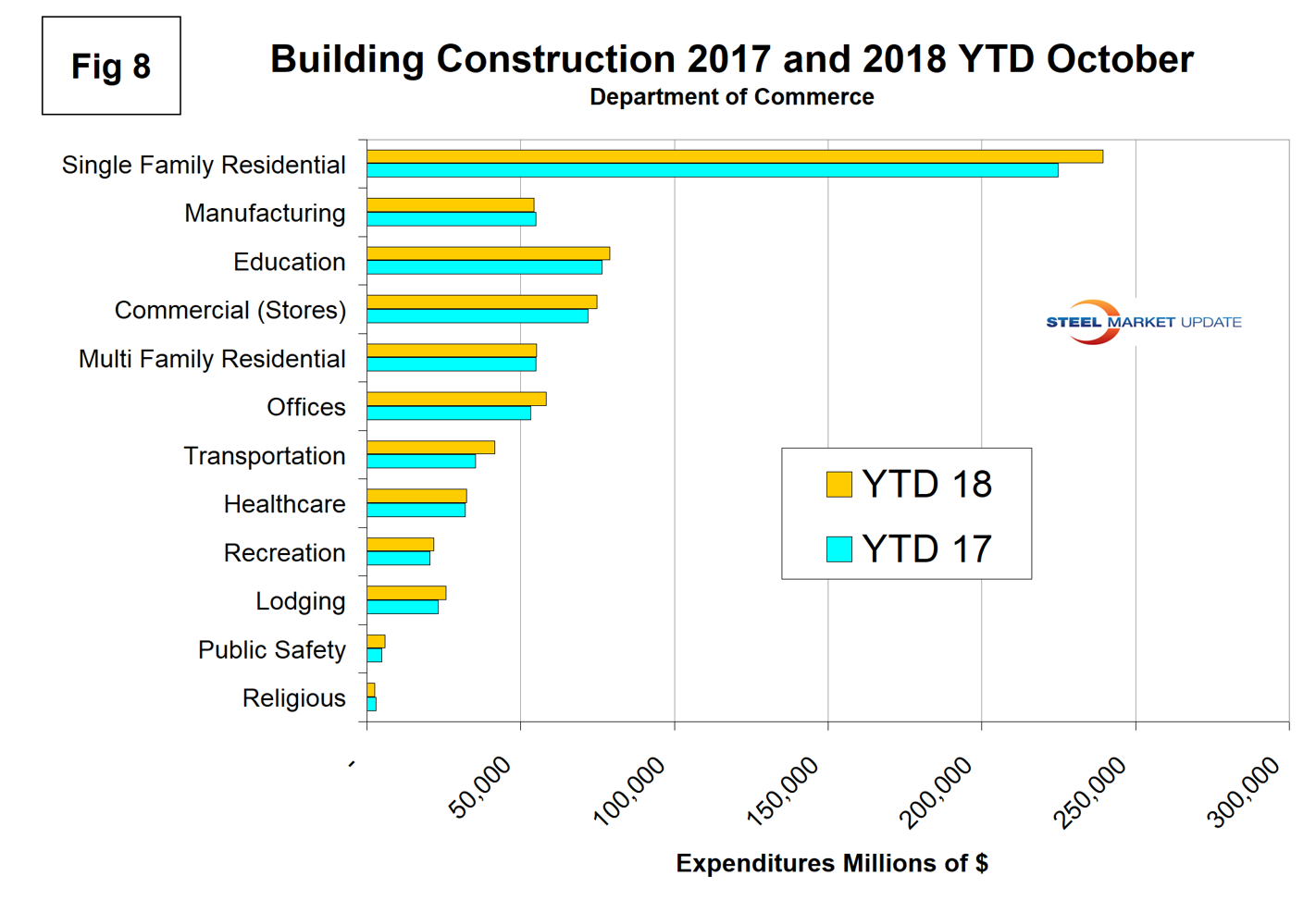
Figure 9 shows total expenditures and growth of nonresidential building construction. Growth slowed in January through July last year, went negative in August through November, then became increasingly positive from December last year through October 2018. On a rolling 12-months basis, expenditures on nonresidential buildings, including both private and S&L, are at an all-time high exceeding the previous best set in December 2008.
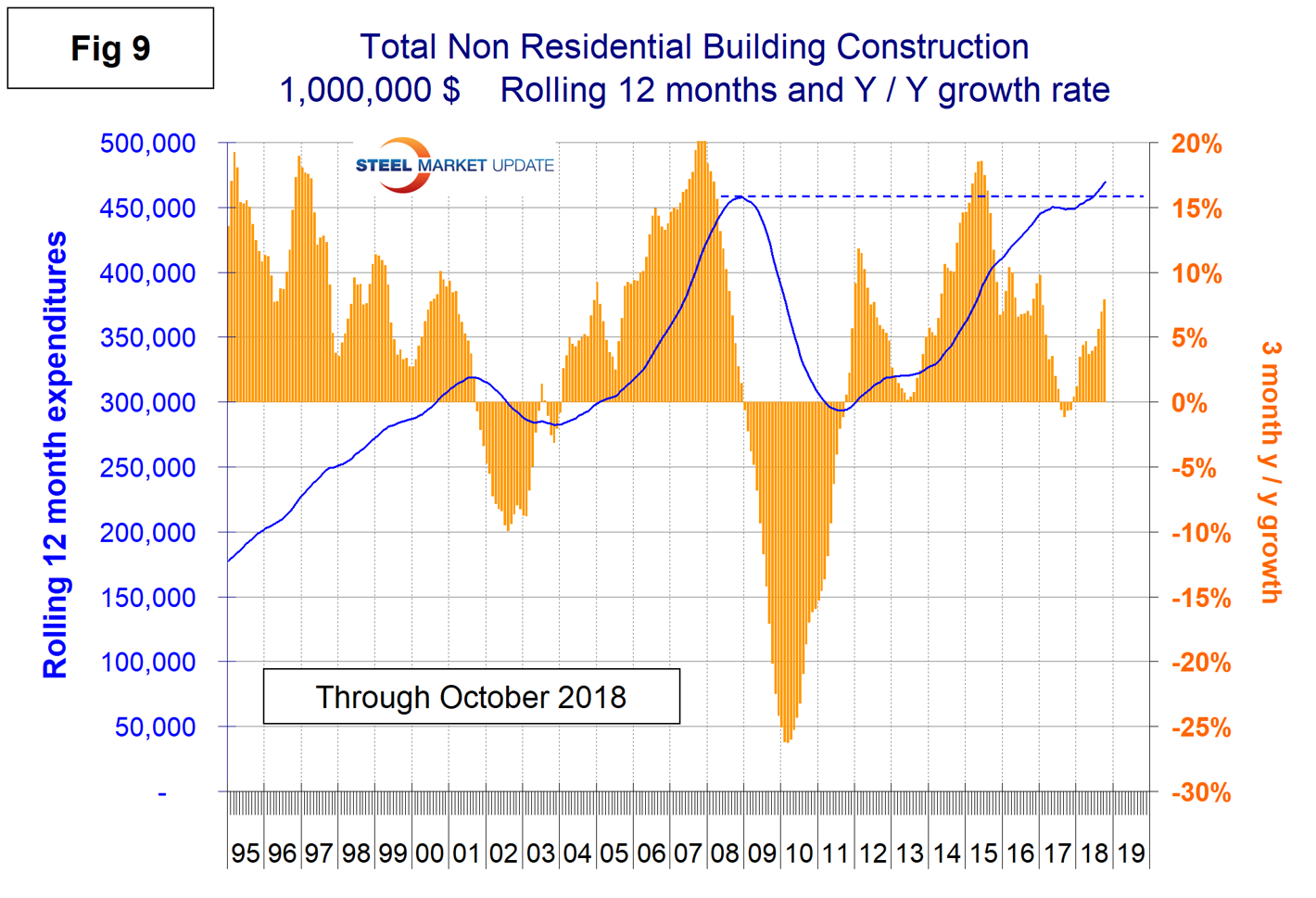
Explanation: Each month, the Commerce Department issues its construction put in place (CPIP) data, usually on the first working day covering activity one month and one day earlier. There are three major categories based on funding source: private, state and local, and federal. Within these three groups are about 120 sub-categories of construction projects. At SMU, we slice and dice the expenditures from the three funding categories to provide as concise a summary as possible of steel consuming sectors. For example, we combine all three to reach a total of nonresidential building expenditures. Construction put in place is based on spending work as it occurs, estimated for a given month from a sample of projects. In effect, the value of a project is spread out from the project’s start to its completion. This is different from the starts data published by the Census Bureau for residential construction, by Dodge Data & Analytics and Reed Construction for nonresidential, and by Industrial Information Resources for industrial construction. In the case of starts data, the whole project is entered into the database when ground is broken. The result is that the starts data can be very spiky, which is not the case with CPIP.
The official CPIP press release gives no appreciation of trends on a historical basis and merely compares the current month with the previous one on a seasonally adjusted basis. The background data is provided as both seasonally adjusted and non-adjusted. The detail is hidden in the published tables, which SMU tracks and dissects to provide a long-term perspective. Our intent is to provide a route map for those subscribers who are dependent on this industry to “follow the money.” This is a very broad and complex subject. Therefore, to make this monthly write-up more comprehensible, we are keeping the information format as consistent as possible. In our opinion, the absolute values of the dollar expenditures presented are of little interest. What we are after is the magnitude of growth or contraction of the various sectors. In the SMU analysis, we consider only the non-seasonally adjusted data. We eliminate seasonal effects by comparing rolling three-month expenditures year over year. CPIP data also includes the category of residential improvements, which we have removed from our analysis because such expenditures are minor consumers of steel.
In the four tables included in this analysis, we present the non-seasonally adjusted expenditures for the most recent data release. Growth rates presented are all year over year and are the rate for the single month’s result, the rolling three months and the rolling 12 months. We ignore the single-month year-over-year result in our write-ups because these numbers are preliminary and can contain too much noise. The growth trend columns indicate momentum. If the rolling three-month growth rate is stronger than the rolling 12 months, we define that as positive momentum, or vice versa. In the text, when we refer to growth rate, we are describing the rolling three-month year-over-year rate. In Figures 1, 2, 6, 7 and 9, the blue lines represent the rolling 12-month expenditures and the brown bars represent the rolling three-month year-over-year growth rates.

Peter Wright
Read more from Peter WrightLatest in Steel Markets

CMC looks beyond Arizona micro-mill woes to long-term viability of construction mart
Despite the economic and geopolitical upheaval of the last five years, CMC President and CEO Peter Matt points out that the construction market has been an essential element of the way forward.

US importers face stricter rules under revamped S232 tariffs
“CBP expects full compliance from the trade community for accurate reporting and payment of the additional duties. CBP will take enforcement action on non-compliance," the agency said in a March 7 bulletin.

Steel exports rebound in January
US steel exports recovered to a five-month high in January after having fallen to a two-year low in December. This growth follows four consecutive months of declining exports.

Construction spending drops marginally in January
Construction spending edged down slightly in January, slipping for the first time in four months. The US Census Bureau estimated spending at a seasonally adjusted annual rate of $2,196 billion in January, down 0.2% from December’s downward revised rate. The January figure is 3.3% higher than a year ago. January’s result, despite the slight erosion, […]

HVAC equipment shipments slow in December but strong annually
Shipments of heating and cooling equipment in the US fell to an 11-month low in December, according to the latest data released by the Air-Conditioning, Heating, and Refrigeration Institute (AHRI).
